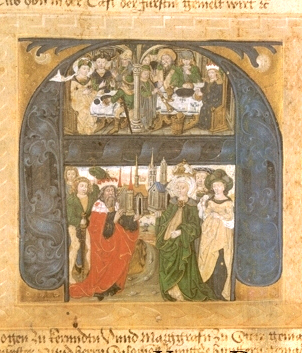Ladislaus Sunthaym on:
[Wikipedia]
[Google]
[Amazon]

 Ladislaus Sunthaym (''Sunthaym, Sunthaim, Sunthain, Sunthaymer'', born c. 1440 in
Ladislaus Sunthaym (''Sunthaym, Sunthaim, Sunthain, Sunthaymer'', born c. 1440 in

 Ladislaus Sunthaym (''Sunthaym, Sunthaim, Sunthain, Sunthaymer'', born c. 1440 in
Ladislaus Sunthaym (''Sunthaym, Sunthaim, Sunthain, Sunthaymer'', born c. 1440 in Ravensburg
Ravensburg ( Swabian: ''Raveschburg'') is a city in Upper Swabia in Southern Germany, capital of the district of Ravensburg, Baden-Württemberg.
Ravensburg was first mentioned in 1088. In the Middle Ages, it was an Imperial Free City and an imp ...
, died 1512 or 1513 in Vienna
en, Viennese
, iso_code = AT-9
, registration_plate = W
, postal_code_type = Postal code
, postal_code =
, timezone = CET
, utc_offset = +1
, timezone_DST ...
) was a German historian, genealogist and geographer.
He studied theology in Vienna and was elected "procurator of the Rhenish nation" (a kind of association of students from the Rhineland in Vienna) in 1460. He received his degree of ''Baccalaureus artium'' in 1465 and acted as a priest in Vienna from 1473. The abbot of Klosterneuburg
Klosterneuburg (; frequently abbreviated as Kloburg by locals) is a town in Tulln District in the Austrian state of Lower Austria. It has a population of about 27,500. The Klosterneuburg Monastery, which was established in 1114 and soon after gi ...
in 1485 asked Sunthaym to compile a family history of Leopold III, Margrave of Austria
Leopold III (german: Luitpold, 1073 – 15 November 1136), known as Leopold the Good, was the Margrave of Austria from 1095 to his death in 1136. He was a member of the House of Babenberg. He was canonized on 6 January 1485 and became the patron ...
in connection with the margrave's canonization. Sunthaym worked on a history and genealogy of the Babenberg
The House of Babenberg was a noble dynasty of Austrian Dukes and Margraves. Originally from Bamberg in the Duchy of Franconia (present-day Bavaria), the Babenbergs ruled the imperial Margraviate of Austria from its creation in 976 AD until its ...
family until 1489, perusing the histories of Otto von Freising and Thomas Ebendorfer. The finished work was exhibited in Klosterneuburg abbey as a richly illuminated parchment manuscript, the so-called ''Tabulae Claustroneoburgenses''. The manuscript was supplemented by a great triptych
A triptych ( ; from the Greek adjective ''τρίπτυχον'' "''triptukhon''" ("three-fold"), from ''tri'', i.e., "three" and ''ptysso'', i.e., "to fold" or ''ptyx'', i.e., "fold") is a work of art (usually a panel painting) that is divided ...
based on the Babenberg family tree, made by the workshop of Hans Part during the period c. 1489 to 1492, for the benefit of the pilgrims visiting Klosterneuburg (now in the monastery museum).
In 1491, the work was published in print by Michael Furter
Michael Furter (died 1516 or 1517) was a printer of incunabula in Basel.
Printing career
The first dated prints by Furter are from 1489. In 1494 he printed the ''Ship of Fools'' by Sebastian Brant for the publisher Jacob Bergmann von Olpe. Fur ...
of Basel. As a result, Sunthaym became widely known as a historiographer. He was a member of the ''Sodalitas litteraria Danubiana'' ("Danubian literary society") in 1498, and Emperor Maximilian charged Sunthaym with a major project of reviewing the genealogy of the House of Habsburg
The House of Habsburg (), alternatively spelled Hapsburg in Englishgerman: Haus Habsburg, ; es, Casa de Habsburgo; hu, Habsburg család, it, Casa di Asburgo, nl, Huis van Habsburg, pl, dom Habsburgów, pt, Casa de Habsburgo, la, Domus Hab ...
.
In 1504, Sunthaym was a member of the chapter of St. Stephen's Cathedral, Vienna.
In 1505, he presented his Habsburg genealogy to the emperor.
Sunthaym's geographical works, covering Austria
Austria, , bar, Östareich officially the Republic of Austria, is a country in the southern part of Central Europe, lying in the Eastern Alps. It is a federation of nine states, one of which is the capital, Vienna, the most populous ...
, Bavaria
Bavaria ( ; ), officially the Free State of Bavaria (german: Freistaat Bayern, link=no ), is a state in the south-east of Germany. With an area of , Bavaria is the largest German state by land area, comprising roughly a fifth of the total l ...
, Swabia
Swabia ; german: Schwaben , colloquially ''Schwabenland'' or ''Ländle''; archaic English also Suabia or Svebia is a cultural, historic and linguistic region in southwestern Germany.
The name is ultimately derived from the medieval Duchy of ...
, the Alsace
Alsace (, ; ; Low Alemannic German/ gsw-FR, Elsàss ; german: Elsass ; la, Alsatia) is a cultural region and a territorial collectivity in eastern France, on the west bank of the upper Rhine next to Germany and Switzerland. In 2020, it had ...
and parts of Franconia
Franconia (german: Franken, ; Franconian dialect: ''Franggn'' ; bar, Frankn) is a region of Germany, characterised by its culture and Franconian dialect (German: ''Fränkisch'').
The three administrative regions of Lower, Middle and Upper ...
, are an important source for the economy and demographics of these regions at the end of the medieval period.
References
*Winfried Stelzer: "Sunthaym, Ladislaus". In: Deutsche Literatur des Mittelalters. Verfasserlexikon. 2nd ed, vol. 9, De Gruyter, Berlin 1995, ; 537–542. {{DEFAULTSORT:Sunthaym, Ladislaus German genealogists German male non-fiction writers 1440s births 1510s deaths Year of birth uncertain Year of death uncertain